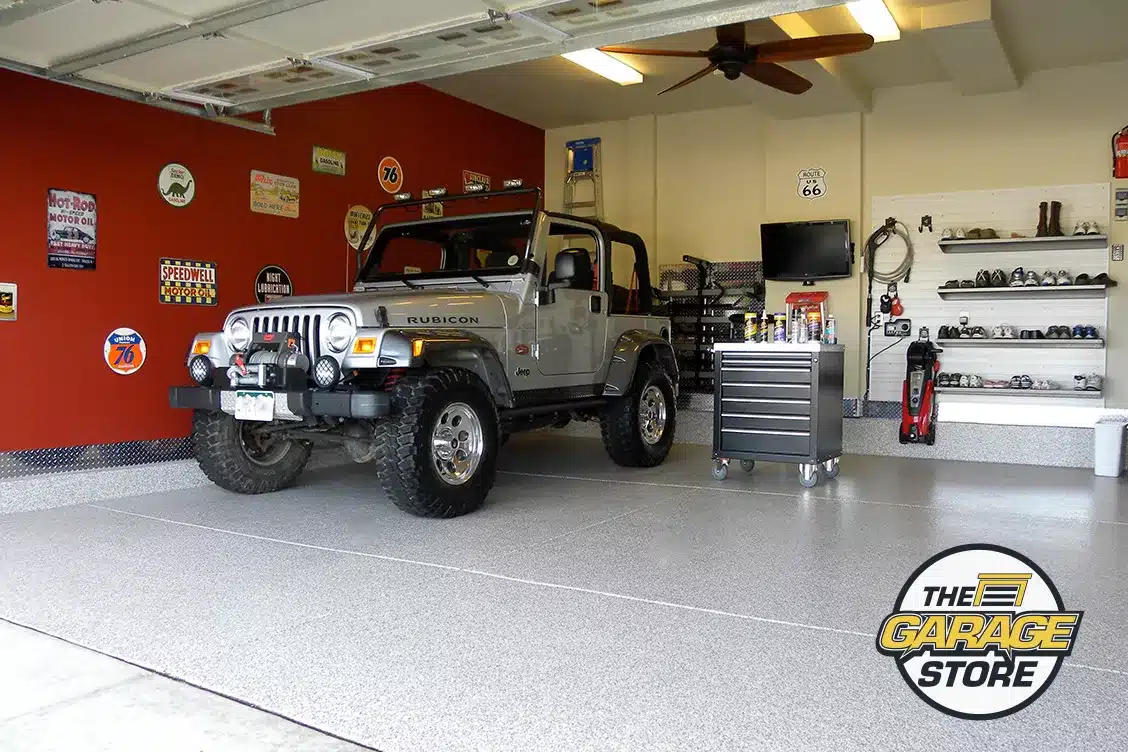Blog submitted by The Garage Store in Calgary.

Epoxy flooring is a popular choice for garage surfaces due to its durability, resistance, and aesthetic appeal. When installed by skilled epoxy floor installers, it can withstand the daily wear and tear of a busy garage environment. However, like any flooring material, epoxy does have a lifespan, and recognizing the signs of wear and tear is crucial in maintaining a functional and visually appealing garage space. Let’s look at some of the key indicators that it might be time to consider replacing your epoxy floor.
Table of Contents
ToggleHow long do epoxy floors last?
Epoxy floors are well-known for their longevity, even in tough garage environments. The lifespan is influenced by several factors, including ambient conditions, usage frequency, and the type of activities taking place on it.
Typically, a well-installed epoxy floor can last anywhere from 10 to 20 years, delivering an excellent return on your initial investment – as most home renovations do. So, if you’ve been in the same home for this long and still haven’t replaced the epoxy floor, or it’s been over a decade since you last did, it’s probably time to consider an upgrade.
Epoxy floor installers in Calgary
Ready to transform your garage with a new epoxy floor? It’s worth it to enlist the expertise of professional installers. The Garage Store takes pride in being among the best epoxy floor installers in Calgary and the surrounding communities. Our commitment extends beyond just installing a new floor – we ensure that every square inch not only looks impressive but is also suited to your needs and built to withstand the demands of the environment.
Why choose epoxy flooring?
Pros of Epoxy Floors
- Compared to concrete, epoxy has a much brighter and cleaner appearance. For extra style, you can even put in coloured chips during the application to match the surrounding area.
- Epoxy is not sticky, and not much will adhere to its surface. This makes it easy to clean and maintain.
- Epoxy is a great way to protect underlying substrates from moisture and damage, provided that it is covered with a good quality sealant.
- Per square foot, epoxy is generally very affordable, and the ROI is high. This will depend quite a bit on the product and the environment, though.
- Different types of epoxies come with different resistances to things like pressure, heat, moisture, chemicals, and electricity. Choose the one that’s best for you, and your epoxy will easily last over a decade.
Cons of Epoxy Floors
- It’s not indestructible. Heavy, concentrated impacts can lead to peeling and cracking, causing damage that will eventually need replacing.
- Some types have little friction, especially if they get wet. It’s recommended to add anti-slip compounds to the top layers of these.
- Most epoxies are not aliphatic – meaning that, in the presence of UV light, they go yellow as they age over time.
- The application takes a lot of dedicated preparation and proper protective gear to work around the chemical fumes and dust. Plus, some types may take days to fully cure. Fluctuating weather and humidity in that time may lead to bubbles, peeling, or adhesion issues. It’s best to leave it to the professional epoxy floor installers!
Signs You Should Replace Your Epoxy Floor
It’s getting faded and yellow.
Epoxy flooring may experience fading and discolouration over time, primarily due to UV damage from sunlight exposure or chemical reactions with elements in moisture and the air. Look for a loss of “gloss” and uneven colour patterns.
Fading diminishes the floor’s aesthetic appeal and may also be a sign of further failures on the horizon. So, if you notice yellowing, replacement may be necessary to keep your garage going strong. Pros like those at The Garage Store can help determine the extent of damage and guide an appropriate response.
There are visible cracks and fractures.
Cracks and fractures in epoxy flooring are critical indicators of underlying damage. These issues can arise from factors such as heavy loads, freeze/thaw cycles, and large impacts.
While minor surface cracks can usually be spot-repaired, widespread or deep fractures that compromise the structural integrity of the floor will require a total replacement.
The surface is becoming pitted and degraded.
Pitting is the formation of small craters or depressions on the surface of epoxy flooring. This deterioration is often caused by chemical exposure, abrasive materials, rocks stuck in tires, and other wear and tear over time. If left unaddressed, these pits can collect water and other fluids, leading to further damage that affects both aesthetics and structural integrity. Depending on the severity, fixing this may involve repairs, protective coatings, or, in severe cases, complete floor replacement.
Moisture and water are seeping in.
Despite epoxy flooring’s inherent resistance to moisture, cracks in the concrete substrate or the epoxy barrier can compromise the floor’s effectiveness. Look for persistent water pooling, dampness, or discolouration beneath the epoxy coating.
If this occurs, it’s a sign that the sealant and barriers are not as strong as they once were. Remediation will mitigate the risk, but full replacements might be necessary if the damage is already done.
The layers are separating (delaminating).
Delamination is the separation of the epoxy floor coating from the underlying concrete surface. It’s a critical issue arising from poor installation, moisture intrusion, or improper curing. When it happens, you’ll see visible peeling, loss of gloss, and surface unevenness as the process weakens the epoxy floor and allows moisture damage to the concrete below. Remediation involves thorough substrate preparation, proper moisture management, and an expert assessment by epoxy floor installers to determine the extent of damage. In severe cases, complete floor replacement may be recommended to ensure long-term durability and maintain a visually appealing garage surface.
The surface is harder to clean and maintain.
Epoxy flooring is known for easy maintenance. If it gets harder to clean than before, this is a sign that there are issues on and under the surface – wear, increased porosity, and degradation of sealants. Persistent stains and a loss of glossiness are key indicators that the epoxy coating may be aged or worn.
These issues can start small but go on to compromise durability in a big way. Fixing them may require nothing more than a good cleaning of a particular spill, but it may also need new sealants or a new surface entirely.
The surface is unstable or uneven.
The presence of noticeable structural instability, such as sagging or unevenness, in epoxy flooring, is often a sign of a bigger issue with the concrete base. This may simply be some bad luck due to shifts in the building’s foundation, influenced by soil settlement or other unforeseen factors.
Uneven or unstable floors can cause drainage issues or cracking, especially if you park heavy vehicles on top. Ignoring these problems poses the risk of further damage – to you, the floor, and your possessions that may be stored nearby.
Replacing Your Garage Epoxy Floor
Replacing the epoxy floors in your Calgary garage can be a game-changer. If you want the experts to handle it, the first step in giving your garage a makeover (whether it’s just the floor or also the cabinets, storage, decor, or accessories) is to chat with us at The Garage Store for a free consultation.
We’ll figure out what suits your needs, measure things up, and give you a price quote for the awesome results you’re looking for. Then, it’s as simple as picking the style you like, and we’ll take care of everything else. Don’t settle for anything less than the best!









